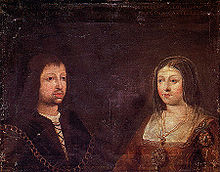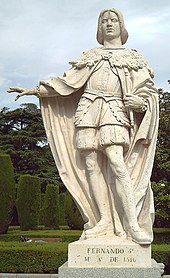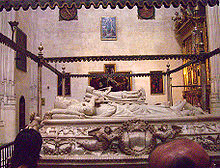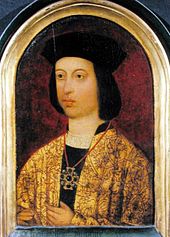Ferdinand II of Aragon: Difference between revisions
Henry Knight (talk | contribs) →Family: template not working |
No edit summary Tag: repeating characters |
||
| Line 1: | Line 1: | ||
PIE!!!!!!!!!!!!!!!!!!!!!!!!!!!!!!!! |
|||
{{pp-move-indef|small=yes}} |
|||
{{Infobox royalty|monarch |
|||
| name =Ferdinand II & V |
|||
| image =Michel Sittow 004.jpg |
|||
| succession =[[King of Aragon]], [[Crown of Aragon|Sicily, Naples, and Valencia]] |
|||
| reign =20 January 1479 - 23 January 1516 |
|||
| coronation = |
|||
| predecessor =[[John II of Aragon|John II]] |
|||
| successor =[[Joanna of Castile|Joanna]] and [[Charles V, Holy Roman Emperor|Charles I]] |
|||
| succession1 =[[King of Castile]] [[Crown of Castile|and Léon]] |
|||
| reign1 =1474 - 1504 |
|||
| predecessor1 =[[Henry IV of Castile|Henry IV]] |
|||
| regent1 =[[Isabella I of Castile|Isabella I]] |
|||
| reg-type1 =Co-monarch |
|||
| successor1 =[[Joanna of Castile|Joanna]] and [[Philip I of Castile|Philip I]] |
|||
| spouse =[[Isabella I of Castile]]<br>[[Germaine of Foix]] |
|||
| issue =[[Isabella, Princess of Asturias (1470-1498)|Isabella, Queen of Portugal]] <br> [[Juan, Prince of Asturias|John, Prince of Asturias]] <br> [[Joanna of Castile]]<br> [[Maria of Aragon (1482-1517)|Maria, Queen of Portugal]] <br> [[Catherine of Aragon|Catherine, Queen of England]] |
|||
| house =[[House of Trastamara]] |
|||
| father =[[John II of Aragon]] |
|||
| mother =[[Juana Enríquez]] |
|||
| date of birth ={{birth date|1452|3|10|df=y}} |
| date of birth ={{birth date|1452|3|10|df=y}} |
||
| place of birth = |
| place of birth = |
||
Revision as of 20:12, 12 October 2009
PIE!!!!!!!!!!!!!!!!!!!!!!!!!!!!!!!! | date of birth =10 March 1452 | place of birth = | date of death =23 January 1516 (aged 63) | place of death = | place of burial =Capilla Real, Granada, Spain}}
Ferdinand the Catholic (Spanish: Fernando II de Aragón y V de Castilla "el Católico", Catalan: Ferran II d'Aragó "el Catòlic", Aragonese: Ferrando II d'Aragón "lo Catolico"; March 10, 1452 – January 23, 1516) was King of Aragon (1479–1516), Sicily (1468–1516), Naples (1504–1516), Valencia, Sardinia, and Navarre, Count of Barcelona, de jure uxoris King of Castile (1474-1504) and then Regent (and true ruler) of that country also from 1508 to his death, in the name of his mentally unstable daughter Joanna the Mad.
Biography
Acquiring titles
Ferdinand was born in Sos del Rey Católico, and was the son of John II of Aragon (whose family was a cadet branch of the House of Trastámara) by his second wife, Juana Enríquez. He married Infanta Isabella, the half-sister and heiress of Henry IV of Castile, on 19 October 1469 in Valladolid and became jure uxoris King of Castile when Isabella succeeded her brother as Queen of Castile in 1474. Isabel also belonged to the royal House of Trastámara. Married under the joint motto, tanto monta, monta tanto, the two young monarchs were initially obliged to fight a civil war against Joan, princess of Castile (also known as Juana la Beltraneja), the purported daughter of Henry IV, and were swiftly successful. When Ferdinand succeeded his father as King of Aragon in 1479, the Crown of Castile and the various territories of the Crown of Aragon were united in a personal union creating for the first time since the 8th century a single political unit referred to as España (Spain), the root of which is the ancient name Hispania, although the various states were not formerly administered as a single unit until the 18th century, but rather, as separate political units under the same Crown.
The first decade of Ferdinand and Isabella's joint rule were taken up with the conquest of the Kingdom of Granada, the last Arab-Muslim state in the Iberian peninsula, which was completed by 1492. In that same year, the Alhambra Decree was issued, expelling all Jews from both Castile and Aragon, and Christopher Columbus was sent by the couple on his expedition (ostensibly bound for east Asia) which resulted in the European arrival in the America. By the Treaty of Tordesillas of 1494, the extra-European world was split between the crowns of Portugal and Castile by a north-south line through the Atlantic Ocean.
Violating the treaty that they had signed with the former King of Granada, which guaranteed religious freedom for Muslims, they forced all Muslims in their dominions to convert to Christianity or else be expelled. The only Muslims that remained were architects, who had designed the Alhambra Palace in Granada. The Muslims who remained discreet, were kidnapped by Spanish inquisitors, and were told to eat a piece of pork. This was also practiced by the Spanish inquisitors on the Jewish population of Spain. The Muslims or Jews who failed to eat pork were expelled from Spain or tortured until they converted to Christianity. The main architect behind the Spanish Inquisition was King Ferdinand II of Aragon. He had over 10,000 Arabic manuscripts burnt in Granada alone. Another task undertook by King Ferdinand II of Aragon was to convert the great mosque of Cordoba into a church, by carving out the dome of the mosque.

The latter part of Ferdinand's life was largely taken up with disputes over control of Italy with successive Kings of France, the so-called Italian Wars. In 1494, Charles VIII of France invaded Italy and expelled Alfonso II (who was Ferdinand's first cousin once removed and stepson of Ferdinand's sister) from the throne of Naples. Ferdinand allied with various Italian princes and with Emperor Maximilian I, to expel the French by 1496 and install Alfonso's son, Ferdinand, on the Neapolitan throne. In 1501, following the death of Ferdinand II of Naples and his succession by his uncle Frederick, Ferdinand of Aragon signed an agreement with Charles VIII's successor, Louis XII, who had just successfully asserted his claims to the Duchy of Milan, to partition Naples between them, with Campania and the Abruzzi, including Naples itself, going to the French and Ferdinand taking Apulia and Calabria. The agreement soon fell apart, and over the next several years, Ferdinand's great general Gonzalo Fernández de Córdoba conquered Naples from the French, having succeeded by 1504. Another less famous "conquest" took place in 1503, when Andreas Paleologus, de jure Emperor of the Eastern Roman Empire, left Ferdinand and Isabella as heirs to the empire, thus Ferdinand became de jure Imperator Constantinopolitanus.
After Isabella

After Isabella's death, her kingdom went to their daughter Joanna. Ferdinand served as the latter's regent during her absence in the Netherlands, ruled by her husband Archduke Philip. Ferdinand attempted to retain the regency permanently, but was rebuffed by the Castilian nobility and replaced with Joanna's husband, who became Philip I of Castile. After Philip's death in 1506, with Joanna supposedly mentally unstable, and her and Philip's son Charles of Ghent was only six years old, Ferdinand resumed the regency, ruling through Francisco Cardinal Jimenez de Cisneros, the Chancellor of the Kingdom.
Ferdinand disagreed with Philip's policies. In 1505, Ferdinand remarried with Germaine of Foix, a granddaughter of his half-sister Queen Leonor of Navarre, in hopes of fathering a new heir and so separating Aragon and Castile (denying Philip the governance of Aragon), and to potentially lay claim to Navarre.

Ferdinand also had children from his mistress, Aldonza Ruiz de Iborre y Alemany of Cervera. He had a son, Alfonso de Aragon (born in 1469), who later became Archbishop of Saragossa, and a daughter Joanna (born in 1471), who married Bernardino de Valsco, the 1st Duke of Frias.
In the 1500s, Alfonso de Aragon, who later became Archbishop of Saragossa, found a hidden study under the palace of Ferdinand containing over 400 documents written by Ferdinand himself. In these documents, Ferdinand explained his general outlook on political power, and his true goals behind all his decisions during life as the King of Spain. Also through these documents, which surprised many people, writings stated that Ferdinand, during times of very complicated decision making, blindfolded himself to concentrate on the true matter of the situation, as to not let various things cloud his judgment[citation needed].
In 1508, war resumed in Italy, this time against Venice, which all the other powers on the peninsula, including Louis XII, Ferdinand, Maximilian, and Pope Julius II joined together against as the League of Cambrai. Although the French were victorious against Venice at the Battle of Agnadello, the League soon fell apart, as both the Pope and Ferdinand became suspicious of French intentions. Instead, the Holy League was formed, in which now all the powers joined together against France.
In November 1511 Ferdinand and his son-in-law Henry VIII of England signed the Treaty of Westminster, pledging mutual aid between the two against France. Earlier that year, Ferdinand had conquered the southern half of the Kingdom of Navarre, which was ruled by a French nobleman, and annexed it to Spain. The Holy League was generally successful in Italy, as well, driving the French from Milan, which was restored to its Sforza dukes by the peace treaty in 1513. The French were successful in reconquering Milan two years later, however.
Ferdinand died in 1516 in Madrigalejo, Extremadura.
Legacy and succession

Ferdinand and Isabella established a highly effective coregency under equal terms. They utilized a prenuptial agreement to lay down their terms. During their reign they supported each other effectively in accordance to their joint motto of equality: Tanto monta or monta tanto, Isabel como Fernando ("They amount to the same, Isabella and Ferdinand"). Isabella and Ferdinand's achievements were remarkable: Spain was united, the crown power was centralized, the reconquista was successfully concluded, the groundwork for the most dominant military machine of the next century and a half was laid, a legal framework was created, the church reformed. Even without the benefit of the American expansion, Spain would have been a major European power. Columbus' discovery set the country on the course for the first modern world power.

In 1502, the members of the Aragonese Cortes gathered in Saragossa, swore an oath of loyalty to their daughter Joanna as heiress, but the Archbishop of Saragossa stated firmly that this oath was invalid and did not change the law of succession which could only be done by formal legislation by the Cortes with the King.[1][2] So, when King Ferdinand died on 23 January 1516, his daughter Joanna inherited the Crown of Aragon, and his grandson Charles became Governor General (Regent).[3] Nevertheless, the Flemings wished that Carlos assume the royal title, and this was supported by his paternal grandfather the Holy Roman Emperor Maximilian I and by Pope Leo X. Consequently, after Ferdinand II's funeral on 14 March 1516, Carlos I was proclaimed King of Castile and of Aragon jointly with his mother. Finally, the Castilian Regent, Cardinal Jiménez de Cisneros accepted the fait accompli, and the Castilian and Aragonese Cortes paid homage to him [4] as King of Aragon jointly with his mother.[5]
Family
With his wife Isabella I the Catholic (whom he married 19 October 1469), King Ferdinand had 5 children:
- Isabella of Castile (1470 - 1498), Princess of Asturias (1497 - 1498). She married first Prince Afonso, Prince of Portugal, but after his death she married his cousin Prince Emanuel, the future King Emanuel I of Portugal. She died in childbirth delivering her son Michael of Paz, Crown Prince of both Portugal and Spain who, in turn, died in infancy;
- Juan, Prince of Asturias (1478 - 1497), Prince of Asturias (1478 - 1497). He married Margaret of Habsburg (daughter of King Maximilian I). He died of tuberculosis and his posthumous child with Margaret was stillborn.
- Joanna the Mad. (1479 - 1555), Princess of Asturias (1500 - 1504), Queen of Castile (1504 - 1555). She married Philip I the Handsome (son of the Emperor Maximilian I) and was the mother of Charles I of Spain (also known as Charles V as Holy Roman Emperor). Incarcerated by her father in Tordesillas, she lived on until her grandson Philip II was already on the throne of Spain;
- Maria of Aragon (1482 - 1517). She married King Emanuel I of Portugal, the widower of her elder sister Isabella and she was the mother of King John III of Portugal and of the Cardinal-King Henry I of Portugal;
- Catherine of Aragon (1485 - 1536). She married first Arthur, Prince of Wales, son of and heir to King Henry VII of England and after Prince Arthur's death she married his brother Henry, Duke of York who also became Prince of Wales and then King Henry VIII. She thus became Queen of England and was the mother of Queen Mary I Tudor (“Bloody Mary”). Eventually, in 1533, she was put aside by King Henry (by a marriage annulment which neither she nor the Pope recognised and which was the prime cause of the English Reformation and the separation of the Church of England from Rome) she died in lonely isolation in Kimbolton Castle in Cambridgeshire and was buried in Peterborough Cathedral.
With his second wife, Germaine of Foix, niece of King Louis XII of France (whom he married on 19 October 1505 in Blois) King Ferdinand had one son, John, who died hours after being born on 3 May 1509.
With his mistress Aldonza Ruiz de Iborre y Alemany, a Catalan noblewoman of Cervera, King Ferdinand had two illegitimate children:
- Alonso (1470 - 1520) Spanish Prelate, Archbishop of Saragossa and Viceroy of Aragón;
- Juana (? - ), married with Bernardino Fernández de Velasco, 1st Duke of Frías
Other illegitimate children King Ferdinand had by various different mothers included:
- Alfonso (1470 - 1530). Fruit of his relationship with Luisa de Estrada, he fought in the Americas;
- Miguel Fernández, the Knight of Granada (1495-1575). Son of Isabel of Granada (born Aixa, daughter of the vanquished Arab King Muhammad XII of Granada, known as Boabdil.) [6]
- Maria (? - ). Abbess of the Royal Convent of Our Lady Mother of Grace at Avila.
- Maria de Aragón. Abbess of the Augustinian Convent of the Holy Mother at Torres Discharges.
Thus, his grandson Charles, was to inherit not only the Spanish lands of his maternal grandparents, but the Habsburg and Burgundian lands of his paternal family, which would make his heirs the most powerful rulers on the continent and, with the discoveries and conquests in the Americas and the Philippines, of the first truly global Empire.
See also: Descendants of Isabella of Castile and Ferdinand of Aragon
Ancestry
| Family of Ferdinand II of Aragon | |||||||||||||||||||||||||||||||||||||||||||||||||||||||||||||||||||||||||||||||||||||||||||||||||||||||||||||||||||||||||||||||||||||||||||||||||||||||||||||||||||||||||||||||||||||||||||||||||||||||||||||||||||||||||||||||||||||||||||||||||||||||||||||||||||||||||||||||||||||||||
|---|---|---|---|---|---|---|---|---|---|---|---|---|---|---|---|---|---|---|---|---|---|---|---|---|---|---|---|---|---|---|---|---|---|---|---|---|---|---|---|---|---|---|---|---|---|---|---|---|---|---|---|---|---|---|---|---|---|---|---|---|---|---|---|---|---|---|---|---|---|---|---|---|---|---|---|---|---|---|---|---|---|---|---|---|---|---|---|---|---|---|---|---|---|---|---|---|---|---|---|---|---|---|---|---|---|---|---|---|---|---|---|---|---|---|---|---|---|---|---|---|---|---|---|---|---|---|---|---|---|---|---|---|---|---|---|---|---|---|---|---|---|---|---|---|---|---|---|---|---|---|---|---|---|---|---|---|---|---|---|---|---|---|---|---|---|---|---|---|---|---|---|---|---|---|---|---|---|---|---|---|---|---|---|---|---|---|---|---|---|---|---|---|---|---|---|---|---|---|---|---|---|---|---|---|---|---|---|---|---|---|---|---|---|---|---|---|---|---|---|---|---|---|---|---|---|---|---|---|---|---|---|---|---|---|---|---|---|---|---|---|---|---|---|---|---|---|---|---|---|---|---|---|---|---|---|---|---|---|---|---|---|---|---|---|---|---|---|---|---|---|---|---|---|---|---|---|---|---|---|---|---|
| |||||||||||||||||||||||||||||||||||||||||||||||||||||||||||||||||||||||||||||||||||||||||||||||||||||||||||||||||||||||||||||||||||||||||||||||||||||||||||||||||||||||||||||||||||||||||||||||||||||||||||||||||||||||||||||||||||||||||||||||||||||||||||||||||||||||||||||||||||||||||
See also
References
- ^ Estudio documental de la moneda castellana de Carlos I fabricada en los Países Bajos (1517); José María de Francisco Olmos, Revista General de Información y Documentación 2003, vol 13, núm.2 (Universidad complutense de Madrid)], page 137
- ^ Estudio documental de la moneda castellana de Juana la Loca fabricada en los Países Bajos (1505-1506); José María de Francisco Olmos, Revista General de Información y Documentación 2002, vol 12, núm.2 (Universidad complutense de Madrid), page 299
- ^ Estudio documental de la moneda castellana de Carlos I fabricada en los Países Bajos (1517); José María de Francisco Olmos,Revista General de Información y Documentación 2003, vol 13, núm.2 (Universidad complutense de Madrid)] page 138
- ^ Historia general de España; Modesto Lafuente (1861), pp. 51-52.
- ^ Fueros, observancias y actos de corte del Reino de Aragón; Santiago Penén y Debesa, Pascual Savall y Dronda, Miguel Clemente (1866), page 64
- ^ Comentarios sobre el Libro "The Moors last sight"; Salman Rushdie, Boabdil:The unfortunate: El Zogoybi por Ranjit Singh
- ^ a b Lundy, Darryl, thePeerage, retrieved 2007-10-25
- ^ a b Lundy, Darryl, thePeerage, retrieved 2007-10-25
- ^ a b Lundy, Darryl, thePeerage, retrieved 2007-10-25
External links
- "Ferdinand II", from Encyclopædia Britannica Online.
- 1452 births
- 1516 deaths
- People from Cinco Villas
- House of Trastamara
- Aragonese monarchs
- Castilian monarchs
- Counts of Barcelona
- Monarchs of Naples
- Kings of Sicily
- De jure uxoris kings
- People of the Reconquista
- Roman Catholic monarchs
- History of Catholicism in Spain
- Jewish Spanish history
- Knights of Santiago
- Knights of the Garter
- Knights of the Golden Fleece
- 15th-century Spanish people
- 16th-century Spanish people
- Burials at Granada Cathedral
